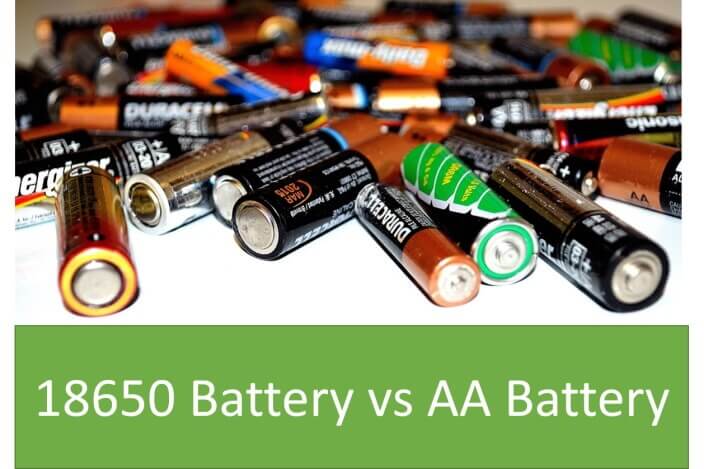Published on: May 19, 2023
Written by Liam Jaxon / Fact-checked by David Rowan
It is unnecessary to say what’s the importance of a battery to operating your equipment. Of the numerous brands and types, 18650 and AA batteries are well-known due to their outstanding features and powerful specifications.
Swing to appoint from a 18650 battery or an AA battery?

Both are cylindrical types of batteries. They have different physical sizes and different chemistries. Even charging or discharging range, capacity, and voltage is not the same as each other.
Devices and appliances can require AA rechargeable/non-rechargeable batteries or 18650 batteries according to their demand. The best solution is to check the manufacturing specifications of your devices along with the batteries.
Now, we will mention the important features and specifications of 18650 and AA batteries. Then, turn on the main point 18650 versus AA batteries.
18650 and AA Batteries Features and Specifications
The 18650 and AA batteries, both are cylindrical batteries that contain different features & specifications. First, we are going to provide you with some basic things about 18650 batteries.
18650 Batteries
The characteristics of the 18650 batteries depending on their brands. These are rechargeable lithium-ion batteries. See the below chart to understand average specifications.
- Physical dimensions of 18.6 x 65.2 mm or ~0.732 x 2.567 inches;
- A nominal capacity from 1800 to 5000 mAh;
- A nominal voltage from 3.2 to 3.7 volts;
- Features a small Battery Management System (BMS);
- The charging and discharging conditions are sensitive.
So, 18650 lithium-ion batteries have a fantastic capacity, nominal voltage, and dimensions. But, these kinds of rechargeable batteries are sensitive. So, you have to use the appropriate 18650 battery chargers.
Some batteries are permitted from BMS which help to keep your battery safe from unwanted events. They are known as “protected batteries”.
Don’t forget to use the inappropriate charger because 18650 lithium-ion batteries are so sensitive. You don’t keep them too hot or too cold.
AA Batteries
The average physical dimensions of most common AA batteries are 14.5 x 50.5 mm or ~0.571 x 1.988 inches. The standard AA battery batteries feature a common nominal voltage of 1.5 volts and a capacity between 1800 and 2700 mAh.
But, rechargeable vs non-rechargeable AA batteries have different chemistries. Depending on chemistries, their nominal voltage & typical capacity can be changed. To get clear data, you have to see the comparison chart of several chemistries.
| Chemistry (General Name) | Battery Type | Typical Voltage (V) | Nominal Capacity (mAh) |
| Alkaline (LR6, 15A) | Non-rechargeable | 1.5 | 1800 – 2700 |
| Zinc Carbon (R6, 15D) | Non-rechargeable | 1.5 | 600 – 1600 |
| Li-FeS2 (FR6, 15LF) | Non-rechargeable | 1.5 (1.8 maximum) | 2700 – 3300 |
| LiFePO4 (IFR14500) | Rechargeable | 3.2 | 500-750 |
| Li-MnO2 (CR AA) | Non-rechargeable | 3.0 | ~2000 |
| Li-ion (14500) | Rechargeable | 3.6 to 3.7 | 600 – 2000+ |
| NiMH (HR6, 1.2H2) | Rechargeable | 1.2 | 700-2800 |
Other chemistries are Li-SOCl2, Lithium, NiCd, NiOOH, NiZn, etc. Li-SOCl2 and NiOOH chemistries are used in non-rechargeable AA batteries. Here Zinc-Carbon is one of the oldest chemistries that features a typical capacity of 600 to 1600 mAh and a nominal voltage of 1.5 volts. This can be replaced by Alkaline AA batteries.
What Is the Difference Between 18650 and Aa Batteries?
The 18650 and AA batteries are two different types of products used to drive the daily essential equipment. The most common dissimilarities are their voltage, capacity, price, and current. The following comparison table provides you with an actual difference between 18650 vs AA batteries.
| Definition | 18650 Battery | AA Battery |
| Chemistry | The 18650 battery is a particular size for a rechargeable lithium-ion battery. | Maximum AA batteries can be alkaline, zinc-carbon, nickel-cadmium, nickel-metal hydride (NiMH), or even lithium-ion among others. |
| Voltage | Maximum 18650 batteries have a nominal voltage of 3.2 to 3.7 volts. | Nickel-Cadmium (NiCD) or Nickel-Metal Hydride (NiMD) AA batteries tend to have a typical voltage of around 1.5V. |
| Physical Size | They have a diameter of 18.6 mm higher than AA batteries and a length of 65.2 mm. | AA batteries feature a diameter of 14.5 and a length of 50.5 mm so quite lower than 18650 batteries. |
| Typical Capacity | These batteries come with around 1800 to 5000 mAh capacity. | Depending on the chemistry, these batteries’ capacity can change. Standard AA alkaline or NiMH battery has a capacity of 1800 to 3000 mAh. |
| Discharge Range | Depending on the cell’s specification, 18650 lithium-ion batteries can charge up to 4.2 volts and down from 2V to 3V. Never discharge lower than 3.0V for safety. | The discharge range of appliances and devices that require AA batteries is 0.9 to 1.5V although some have lower voltage just like Panasonic Eneloop AA batteries. |
What Are the Benefits of Using a 18650 Battery Over an AA Battery?
The main benefits of using a 18650 battery over a AA battery are:
- Higher capacity: 18650 batteries typically have a much higher capacity than AA batteries, meaning they can store more energy and therefore last longer.
- Higher voltage: 18650 batteries typically have a higher voltage than AA batteries, meaning they can provide more power to devices that require it.
- Rechargeable: 18650 batteries are rechargeable while AA batteries are not, this allows you to use the battery multiple times instead of having to replace it.
- Durability: 18650 batteries are also more durable than AA batteries because they have a thicker metal casing that can withstand more wear and tear.
- Size: 18650 batteries are slightly bigger than AA batteries, which can be a disadvantage in some applications, but in other cases, it’s not an issue.
Overall, 18650 batteries are more suitable for high-drain devices, such as flashlights, electric bikes, power tools, and some other portable devices.
What Are the Downsides of Using a 18650 Battery Over an AA Battery?
There are several downsides to using a 18650 battery over a AA battery:
- Size: 18650 batteries are larger and bulkier than AA batteries, which can make them less convenient to carry around or use in portable devices.
- Voltage: 18650 batteries typically have a higher voltage than AA batteries, which can make them less compatible with certain devices or require voltage regulation.
- Capacity: While 18650 batteries have a higher capacity than AA batteries, they also have a higher self-discharge rate, which means they lose their charge faster when not in use.
- Safety: 18650 batteries are typically lithium-ion, which can be more volatile and pose a higher risk of fire or explosion if not handled properly.
- Cost: 18650 batteries can be more expensive than AA batteries, especially if you need multiple batteries to power your device.
- Charging: 18650 batteries can only be charged with a specific charger and not with any old charger.
- Replacement: 18650 batteries are less readily available and may be harder to find and replace than AA batteries.
Frequently Asked Questions
Can AA Batteries Be Used in Place of 18650?
It is not possible to use AA batteries in place of 18650 batteries. The nominal voltage and capacity of the 18650 are significantly different from the AA cell. The 18650 battery runs at around 3.7 volts, and around 3000 milliamp hours where AA batteries require 1.5 volts for around 1800 Milliamp hours. But, the 18650 battery is equivalent to the 21700 batteries that are rechargeable lithium-ion cells.
What Are the Advantages of Using Rechargeable Lithium Batteries Like the 18650 over Non-Rechargeable AA Batteries?
The benefits of using rechargeable lithium AA batteries like the 18650 over non-rechargeable AA batteries are substantial. They offer a longer lifespan, are cost-effective in the long run, and are more environmentally friendly as they can be reused multiple times. Investing in rechargeable lithium AA batteries can save you money and reduce waste.
Are 18650 Batteries Bigger Than AA Batteries?
Yes, 18650 batteries are slightly bigger than AA batteries. The physical size of the 18650 lithium-ion cell battery is 18mm x 65mm higher than 14mm x 50mm. Both are suitable for application in high-drain devices like laptops, flashlights, and so on.
Is A 3.7 Volt Battery the Same as an AA Battery?
Yes, some 3.7-volt batteries are the same as AA batteries. AA batteries and Lithium-ion 14500 batteries are interchangeable, with only a difference in their output voltage.
The Bottom Line
At the end of the day, you have no confusion about opt-in to either 18650 batteries or AA batteries. We would always recommend you justify the product features & specifications.
Though an AA and a 18650 are two contrasting batteries, both play a vital role in powering your devices. Their diameter and length are not comparable to each other. Another difference between AA and 18650 batteries is store energy and output power.
Read more:
- Comparison Between Dry Cut Saw And Band Saw
- Can a Licensed Electrician Illuminate Your Solar Dreams?
- How to Connect Trolling Motor to Battery
About This Writer

Hi, I am responsible for the 'Homeowners Power Solutions' category. My name is Liam Jaxon and a licensed technician with 7 years of experience in vehicle batteries, electrical gadgets, and home appliances. My working experience in different residential & light commercial electrical sectors and the automobile industry helped to acquire vast knowledge in this industry.